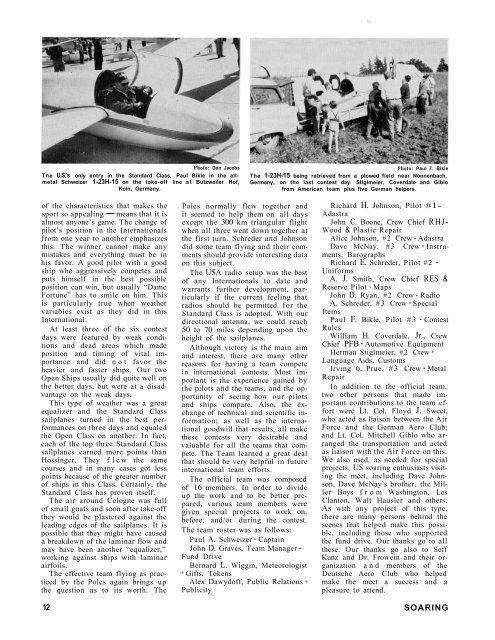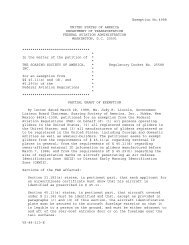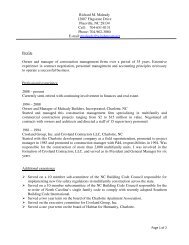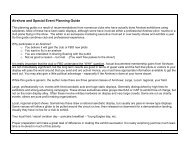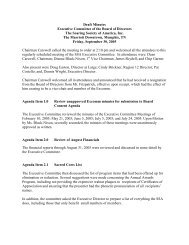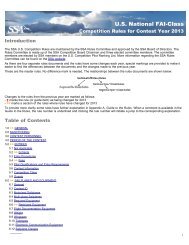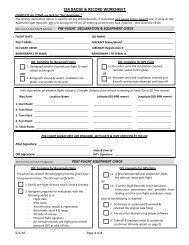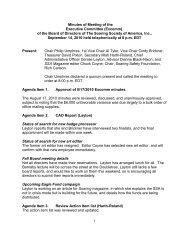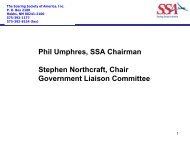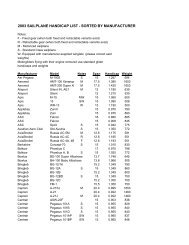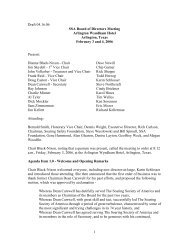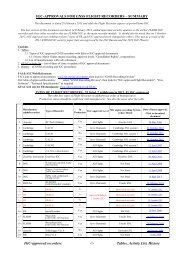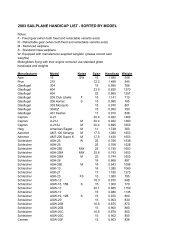1960 World Gliding Championships - Soaring Society of America
1960 World Gliding Championships - Soaring Society of America
1960 World Gliding Championships - Soaring Society of America
Create successful ePaper yourself
Turn your PDF publications into a flip-book with our unique Google optimized e-Paper software.
Photo: Don Jacobs<br />
The U.S.’s only entry in the Standard Class, Paul Bikle in the allmetal<br />
Schweizer 1-23H-15 on the take-<strong>of</strong>f line a t Butzweiler H<strong>of</strong>,<br />
Koln, Germany.<br />
<strong>of</strong> the characteristics that makes the<br />
sport so appealing-means that it is<br />
almost anyone’s game. The change <strong>of</strong><br />
pilot’s position in the Internationals<br />
from one year to another emphasizes<br />
this. The winner cannot make any<br />
mistakes and everything must be in<br />
his favor. A good pilot with a good<br />
ship who aggressively competes and<br />
puts himself in the best possible<br />
position can win, but usually “Dame<br />
Fortune” has to smile on him. This<br />
is particularly true when weather<br />
variables exist as they did in this<br />
International.<br />
At least three <strong>of</strong> the six contest<br />
days were featured by weak conditions<br />
and dead areas which made<br />
position and timing <strong>of</strong> vital importance<br />
and did n o t favor the<br />
heavier and faster ships. Our two<br />
Open Ships usually did quite well on<br />
the better days, but were at a disadvantage<br />
on the weak days.<br />
This type <strong>of</strong> weather was a great<br />
equalizer and the Standard Class<br />
sailplanes turned in the best performances<br />
on three days and equaled<br />
the Open Class on another. In fact,<br />
each <strong>of</strong> the top three Standard Class<br />
sailplanes earned more points than<br />
Hossinger. They f 1e w the same<br />
courses and in many cases got less<br />
points because <strong>of</strong> the greater number<br />
<strong>of</strong> ships in this Class. Certainly, the<br />
Standard Class has proven itself.<br />
The air around Cologne was full<br />
<strong>of</strong> small gnats and soon after take-<strong>of</strong>f<br />
they would be plastered against the<br />
leading edges <strong>of</strong> the sailplanes. It is<br />
possible that they might have caused<br />
a breakdown <strong>of</strong> the laminar flow and<br />
may have been another “equalizer,”<br />
working against ships with laminar<br />
airfoils.<br />
The effective team flying as practiced<br />
by the Poles again brings up<br />
the question as to its worth. The<br />
Poles normally flew together and<br />
it seemed to help them on all days<br />
except the 300 km triangular flight<br />
when all three went down together at<br />
the first turn. Schreder and Johnson<br />
did some team flying and their comments<br />
should provide interesting data<br />
on this subject.<br />
The USA radio setup was the best<br />
<strong>of</strong> any Internationals to date and<br />
warrants further development, particularly<br />
if the current feeling that<br />
radios should be permitted for the<br />
Standard Class is adopted. With our<br />
directional antenna, we could reach<br />
50 to 70 miles depending upon the<br />
height <strong>of</strong> the sailplanes.<br />
Although victory is the main aim<br />
and interest, there are many other<br />
reasons for having a team compete<br />
in international contests. Most important<br />
is the experience gained by<br />
the pilots and the teams, and the opportunity<br />
<strong>of</strong> seeing how our pilots<br />
and ships compare. Also, the exchange<br />
<strong>of</strong> technical and scientific information;<br />
as well as the international<br />
goodwill that results, all make<br />
these contests very desirable and<br />
valuable for all the teams that compete.<br />
The Team learned a great deal<br />
that should be very helpful in future<br />
international team efforts.<br />
The <strong>of</strong>ficial team was composed<br />
<strong>of</strong> 16 members. In order to divide<br />
up the work and to be better prepared,<br />
various team members were<br />
given special projects to work on,<br />
before, and/or during the contest.<br />
The team roster was as follows:<br />
Paul A. Schweizer - Captain<br />
John D. Graves, Team Manager -<br />
Fund Drive<br />
Bernard L. Wiggin, Meteorologist<br />
- Gifts, Tokens<br />
Alex Dawyd<strong>of</strong>f, Public Relations -<br />
Publicity<br />
Photo: Paul F. Bikle<br />
The 1-23H-15 being retrieved from a plowed field near Nonnenbach,<br />
Germany, on the last contest day. Stiglmeier, Coverdale and Giblo<br />
from <strong>America</strong>n team plus five German helpers.<br />
Richard H. Johnson, Pilot #1-<br />
Adastra<br />
John C. Boone, Crew Chief RHJ-<br />
Wood & Plastic Repair<br />
Alice Johnson, #2 Crew - Adastra<br />
Dave McNay, #3 Crew - Instruments,<br />
Barographs<br />
Richard E. Schreder, Pilot #2 -<br />
Uniforms<br />
A. J. Smith, Crew Chief RES &<br />
Reserve Pilot - Maps<br />
John D. Ryan, #2 Crew - Radio<br />
A. Schreder, #3 Crew - Special<br />
Items<br />
Paul F. Bikle, Pilot #3 - Contest<br />
Rules<br />
William H. Coverdale, Jr., Crew<br />
Chief PFB - Automotive Equipment<br />
Herman Stiglmeier, #2 Crew -<br />
Language Aids, Customs<br />
Irving 0. Prue, #3 Crew - Metal<br />
Repair<br />
In addition to the <strong>of</strong>ficial team,<br />
two other persons that made important<br />
contributions to the team effort<br />
were Lt. Col. Floyd J. Sweet,<br />
who acted as liaison between the Air<br />
Force and the German Aero Club,<br />
and Lt. Col. Mitchell Giblo who arranged<br />
the transportation and acted<br />
as liaison with the Air Force on this.<br />
We also used, as needed for special<br />
projects, US soaring enthusiasts visiting<br />
the meet, including Dave Johnson,<br />
Dave McNay’s brother, the Miller<br />
Boys from Washington, Les<br />
Clanton, Walt Hausler and others.<br />
As with any project <strong>of</strong> this type,<br />
there are many persons behind the<br />
scenes that helped make this possible,<br />
including those who supported<br />
the fund drive. Our thanks go’to all<br />
these. Our thanks go also to Seff<br />
Kunz and Dr. Frowein and their organization<br />
a n d members <strong>of</strong> the<br />
Deutsche Aero Club who helped<br />
make the meet a success and a<br />
pleasure to attend.<br />
12 SOARING


